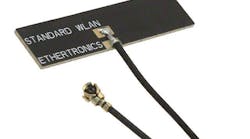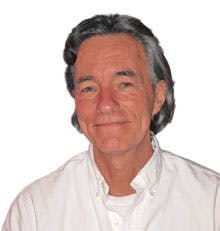This file type includes high-resolution graphics and schematics when applicable.
Jeff Shamblin, Chief Scientist at Ethertronics, is responsible for overseeing all research and development projects for the corporation. Prior to joining Ethertronics, Shamblin worked for two RFID startup companies: SCS Corp. and Claridy Solutions. He has also served as an antenna consultant, providing design and analysis services to several wireless startups in the Southern California area. On top of that, Shamblin spent more than 20 years in antenna design and development in the aerospace industry at Lockheed Martin and Northrop Grumman. He holds seven patents related to antenna technology. Shamblin earned his bachelor’s degree in physics from California State University, Northridge.
How has the approach to developing antenna solutions changed in the last five or 10 years?
Antenna design for consumer and commercial applications has undergone a few significant changes. One has been to put more emphasis on a system-level approach for the antenna system, where the antenna is designed for optimal RF system operation and for operation in conjunction with the many sensors that now populate a consumer mobile device, such as proximity sensors. A system-level approach is important to optimize the four to six antennas that now populate a smartphone, where isolation and correlation between the multiple antennas will, to a large extent, dictate the data rate that can be achieved, the quality of a voice call, or the accuracy of an embedded GPS receiver.
A second change involves designing the antenna system for the specific use cases that will likely be applied to the mobile device. For example, antenna performance can be optimized for a hand-loading condition for a smartphone, or a body-loading condition for a wearable fitness tracker.
What are some of the challenges in terms of developing antennas for cellular communications?
The increased number of cellular bands dedicated to LTE systems along with carrier aggregation, where two or more frequencies are aggregated to improve communication-system throughput, have added complexity to the multiple-input, multiple-output (MIMO) antenna system in a smartphone. Also, the trend to bring 2 × 2 MIMO at Wi-Fi frequencies to the smartphone requires the integration of additional antennas into a small, compact volume.
Wi-Fi has advanced significantly over the years, and it continues to transform. How will that affect antenna design—both now and in the future?
The main affect will be an added requirement to integrate a larger number of antennas into a device as higher orders of MIMO are brought to bear to increase data rates. Wi-Fi routers today will typically have three or four antennas installed to provide 3 × 3 or 4 × 4 MIMO capability—and 8 × 8 MIMO will soon be available for the Wi-Fi market.
Tell us a little bit about Active Steering technology.
Ethertronics has developed a technique to generate multiple radiation patterns from a single antenna structure. A small-form-factor antenna, along with a four-port switch and algorithm, comprise an Active Steering antenna system. The radiation pattern of the single antenna can be dynamically changed. The proprietary algorithm accesses a metric from the baseband processor—for example, SINR or RSSI. This metric is used to determine the radiation mode for optimal throughput. The end result is improved throughput and a more reliable communication link for cellular and Wi-Fi applications.
How have antenna testing requirements changed throughout the years?
In the cellular industry, handset antenna requirements have progressed from tracking radiation patterns and efficiency for 2G/3G systems to tracking total radiated power (TRP) and total isotropic sensitivity (TIS) performance for 3G systems. Requirements now include isolation and envelope correlation coefficient for 4G MIMO antenna systems. Another change has been to measure and use system-level performance metrics, such as throughput in Wi-Fi systems, to optimize the antennas during the antenna integration process.
What challenges will the Internet of Things (IoT) bring to antennas?
Interference mitigation will become more important as a larger number of RF-enabled devices are installed in homes and businesses. Reliability of the communication link will also be important for this plurality of IoT devices to allow for continuous and seamless monitoring of a wide variety of devices. Ethertronics’ Active Steering technology will be able to assist in decreasing interference, as well as making the RF communication links more reliable by bringing antenna diversity to each antenna port.
What impact do you think 5G will have on antenna development?
Some 5G implementations will require millimeter-wave antenna systems integrated into handheld and mobile devices, and these millimeter-wave antennas will require different manufacturing techniques to maintain tolerances and allow for better material selection. Millimeter-wave applications will require better control of the radiation pattern in comparison to 3G and 4G systems.
Another impact that will affect 5G systems at both sub-10-GHz and millimeter-wave frequencies will be the use of higher orders of MIMO to drive higher data rates. The need to integrate a larger number of antennas in a device where isolation and envelope correlation must be designed will create more difficulties in antenna-system design. Good antenna-system design practices will be required for optimized 5G communication systems.



